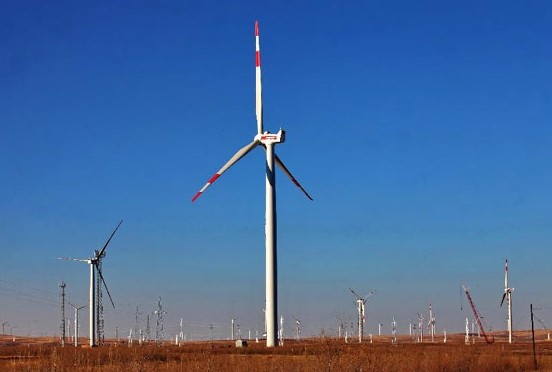

Photo taken on Jan. 15, 2014 shows a wind power plant on the Bashang Grassland in north China's Hebei Province. (Xinhua/Yang Shiyao)
China.s moderate economic expansion of 7.7 percent in 2013 will provide room for quality growth as China is well on track of rebalancing its economy.
In 2013, despite downward pressure both at home and abroad, China.s economy expanded by 7.7 percent, steady from 2012 and exceeding the government's 7.5 percent target, according to the National Bureau of Statistics.
After 30 years of sizzling double-digit growth that not only has wrought damage on the environment but also has allowed imbalances to build up, making the economy rely more on investment than domestic consumption.
Although the growth was the lowest in the past 14 years, analysts said, "To be sure, the gentle fall-off in growth is welcomed by most experts as a must-have in China as it transits to better-quality development."
World Bank President Robert Zoellick told the Wall Street Journal, "China's leadership has recognized that China needs to change its growth model."
"It won't be a Big Bang process. We'll see, in Chinese fashion, a series of steps, which if successful, will pick up momentum," Zoellick added.
Ryan Rutkowski, a researcher with the Washington-based Peterson Institute for International Economics, is sure that the 7.7-percent growth is a positive signal.
He noted that China.s economy last year showed a new feature that the contribution of service sector to GDP outpaced that of industry for the first time, underlining the achievements of economic readjustment.
According to NBS, China's economic structuring was improved, with higher proportion of the tertiary sector, which took up a 46.1-percent share in the GDP structure, up from 44.6 percent in 2012 and exceeding the secondary sector for the first time.
Besides the change of weights of the sectors in the national economy, the contribution to GDP of three major drivers of the economy -- investment, consumption and exports -- also changed.
Though investment contributed 54 percent, still exceeding the share of consumption, it is worth noting that the growth of investment in fixed assets dropped to 19.6 percent, the first time below the 20 percent mark in the past 10 years.
New York Times reported that China.s economy has been cooling down over the past two years, which can be seen from the industrial output, and fixed asset investment.
"But retail sales, which give a sense of how spending among China's 1.3 billion inhabitants is holding up, have remained relatively firm," the paper said.
At a key Communist Party session in November, China revealed an ambitious reform agenda intended to shift its growth model to one less polluting, more balanced and sustainable.
A Spanish website the .www.politica-china.org. said China was still the world.s second largest economy, with more than 10 million new jobs created and inflation kept at 2.6 percent for the whole year.
The economic slowdown can provide leeway for the coming readjustment of economy, the website assessed.
Its German counterpart the.www.welt.de.saw the moderate slowdown as the result of structural reform, which will keep China.s economy on the track of sustainable development and be environmentally friendly, resource-efficient and focusing on domestic market in the new year.
Looking ahead for 2014, the analysts are optimistic and predict China.s economy will gradually adjust without seeing a major setback or financial crisis.
They say China will undergo a rebalance by shifting away from investment and exports for growth and by relying more on consumption.
China may receive a boost as demand for Chinese exports from strengthening developed economies, led by the U.S., picks up in 2014.
"We expect China to benefit from improved global growth this year," said Louis Kuijs, an economist at RBS in Hong Kong.
A report on BBC website pointed out that China will take various steps to open up new avenues of long-term growth, including pushing forward interest rate liberalization and launching new free trade zones, like the one in Shanghai.
They add that China.s growth will make room for reforms, but saying putting the plans into action won't be easy and gains may not be reflected any time soon.
"It's like a Chinese medicine," said Lu Zhengwei, chief economist at Industrial Bank in Shanghai.
"If you don't take it, you may have problems in future. But if you take it now, you cannot expect to regain your youth tomorrow," Lu said.
"We are likely to see a continuation of slower but more sustainable investment growth in 2014 as policy makers focus on rebalancing the economy to domestic consumption," said a research note from Moody's Analytics.
.The reform package that the leadership has laid out would in time boost growth but, in the near term, efforts to rein in the expansion of credit will sap demand,.said Mark Williams, chief China economist at Capital Economics.
Copyright ©1999-2018
Chinanews.com. All rights reserved.
Reproduction in whole or in part without permission is prohibited.